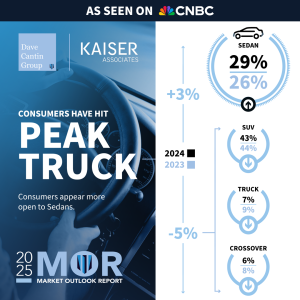
Summary
Outlook for 2025: One Month In The S&P 500 ended January with a 2.7% gain, but has struggled in February. The same positive fundamentals that drove 2024 gains were in place to begin 2025. Fourth-quarter earnings growth has been the strongest in nearly three years. Unemployment remains low, and the economy (GDP) grew just under 3% in 2025. Still, there are currents of unease that have kept volatility high and contributed to outsized daily moves in the major stock indices. The Fed is ‘in no hurry’ to cut interest rates further. Also overhanging the market is the perception that stocks are fully valued, and that it has been a long time since the last correction in equities. The imposition of tariffs is contributing to uncertainty, as is the effective shutdown of government agencies. Every change in presidential administration brings change, and the market seems determined to remain on course regardless of the new broom in Washington. Summary Outlook for 2025 In 2023, the stock market broke out of its 2022 funk on the perception that inflation was in retreat, the Fed would wrap its rate-hiking campaign, and the supply chain would get back to a ‘new normal.’ All of those things happened more or less, and the market rallied as anticipated. In 2024, economic growth strengthened; corporate earnings growth accelerated; and jobs growth continued to defy expectations. Inflation moved lower but stalled at the ‘last mile’ between 3% and 2%. And market interest rates fell sharply on Fed rate cuts in September before bouncing higher as 2024 ended. The election of Donald Trump to a second term sent stocks soaring in November, while the more-cautious tone from the Fed sent stocks crashing in December. The volatility in stocks that characterized the final two months of the year has continued early in 2025. For the past three years, investors have been attuned to monetary policy as the Fed sought to reduce inflation. Investors’ focus in 2025 likely will shift to fiscal policy. The new administration is pledging further tax cuts, while tariffs and deportations risk rekindling inflation. The major geopolitical event of 2023 — the war between Israel and Hamas — continued into 2024 and now 2025. That war briefly broadened into Lebanon and Iran, but the two sides are now in the midst of an uneasy cease-fire and prisoner exchange. The long-stalled war in Ukraine could reach a new phase in 2025 as Donald Trump seeks an end to the conflict. Economic activity in China, the world’s second-largest economy, remains tepid. The government’s ambitious fiscal-stimulus program to spur economic recovery has had mixed results, partly reflecting demographic factors. Notwithstanding these and other challenges, the global macro-environment appears moderately positive for U.S. stocks. Measures of the commercial and industrial economy — including manufacturing PMIs, durable goods orders, and industrial production — moderated in 2024. Sentiment indicators such as small-business confidence surged on Donald Trump’s election. Weariness with inflation and high financing rates continued to weigh on consumer confidence in 2024. The consumer outlook could begin to brighten if inflation were to slow and lower rates spur home and vehicle purchases in 2025. We expect the U.S. economy to continue expanding in 2025, remaining on a narrow growth path in line with subdued population growth and higher productivity. Following 2.9% GDP growth in 2023 and 2.8% GDP growth for 2024, Argus is modeling 2025 GDP growth of 2.1%. The Fed successfully reduced inflation growth, although getting to the Fed’s 2% target has proven to be challenging. The federal funds rate was 4.25%-4.5% as of December 30, 2024, while the core PCE Inflation Index was up 2.8% on an annual basis. Based on changes in the Fed’s ‘dot plot,’ we now expect any rate cuts in 2025 to be backloaded to the second half. Argus expects short-term yields to move gradually lower from current levels. Long yields have moved higher and are expected to widen their relative premium to short yields. The dollar rallied in fall 2024 with higher Treasury rates and President Trump’s pro-growth platform. The U.S. dollar index increased 7% in 2024 and currently is at least 20% above historical averages. The relative strength of the U.S. economy and demand for U.S. investments may keep the dollar firm in 2025. Energy prices have been volatile: rising in fall 2023, declining in winter 2024, rising again in spring 2024, and falling into year-end 2024. President Trump has promised to ‘drill, baby, drill,’ and that has actually been a mild depressant on energy prices. We look for reasonable balance in the supply-demand equation to keep energy prices relatively stable in 2025. Corporate earnings in 2024 rebounded from 2023, which was a year of mainly negative EPS comparisons. Ahead of 4Q24 EPS season, we maintained our 2024 estimate of S&P 500 earnings from continuing operations of $247. For 2025, our forecast for S&P 500 earnings from continuing operations is $276, implying full-year EPS growth of 12%. For 2026, our forecast is $307, implying EPS growth of 11%. Our stock/bond barometer is signaling that stocks are trading at a slight premium to the historical mean reading and that bonds offer the better value of the two asset classes. Stock valuations remain attractive, however, given accelerating EPS growth, lower inflation, and still-low (though rising) long yields. We believe the healthy rotation toward rate-sensitive, defensive, and cyclical categories that categorized most of 2024 will continue in 2025. That was certainly reflected in January, a month in which Information Techno



